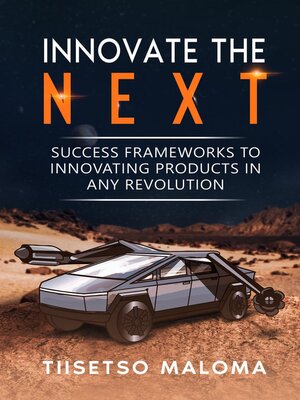Innovate the Next
ebook ∣ Success Frameworks to Innovating Products in Any Revolution
By Tiisetso Maloma

Sign up to save your library
With an OverDrive account, you can save your favorite libraries for at-a-glance information about availability. Find out more about OverDrive accounts.
Find this title in Libby, the library reading app by OverDrive.



Search for a digital library with this title
Title found at these libraries:
| Library Name | Distance |
|---|---|
| Loading... |
Innovate The Next is the 7th book by author and entrepreneur Tiisetso Maloma.
The core teaching of the book is how one can become an innovator of novel products (physical and virtual) in any industrial revolution.
It is targeted at entrepreneurs, employees and innovation enthusiasts.
To understand and master a thing, one has to understand how it forms, unfolds and evolves.
Chapter One takes to evolutionary biology to form this understanding of innovation evolution (manmade and biological).
After all, biology gave humans the brain they innovate with.
It looks at the factors pre-determining the success or failure of biological and manmade innovations. To achieve this it borrows the 'Adjacent Possible Theory' from biology. The theory was devised by theoretical biologist Stuart Alan Kauffman.
To drive this guide methodically, Tiisetso Maloma devised a set of factors entitled 'Enabling factors for products success with the Adjacent Possible.'
Namely, they are: (a) Behavioural Utility, (b) Innovation (adjacent possible stacking, or stacking for agility), (c) Location Specific Adjacent Possible Advantages, (d) Spaza/Convenience Metrical Interest/Advantage of a Product, (e) Business Model, and (f) Luck.
Their use is to analyse, evaluate and strengthen any product innovation or idea.
Chapter Two connects the success or failure of manmade innovations to evolutionary psychological-inclinations through Tiisetso Maloma's devised Human Greed Pyramid.
The pyramid illustrates how product success is allowed and or disallowed by human inclinations.
Chapter Three plots how inclinations can be plotted into innovation.
Chapter Four reverse engineers the models illustrated in the book into what skills can one hone to become an innovator of novel products. It draws scenarios for entrepreneurs, employees and innovation aspirants.
Chapter Five connects the models learned throughout the book to understand the current (Fourth) Industrial Revolution and its technologies: robotics, artificial intelligence, nanotechnology, quantum computing, biotechnology, the Internet of Things, decentralized consensus, 5G, 3D printing and autonomous vehicles.
It sheds light on key innovation concepts such as Moore's Law, exaptation, and convergence.
It is a chapter on how to see into the future as an innovator.







